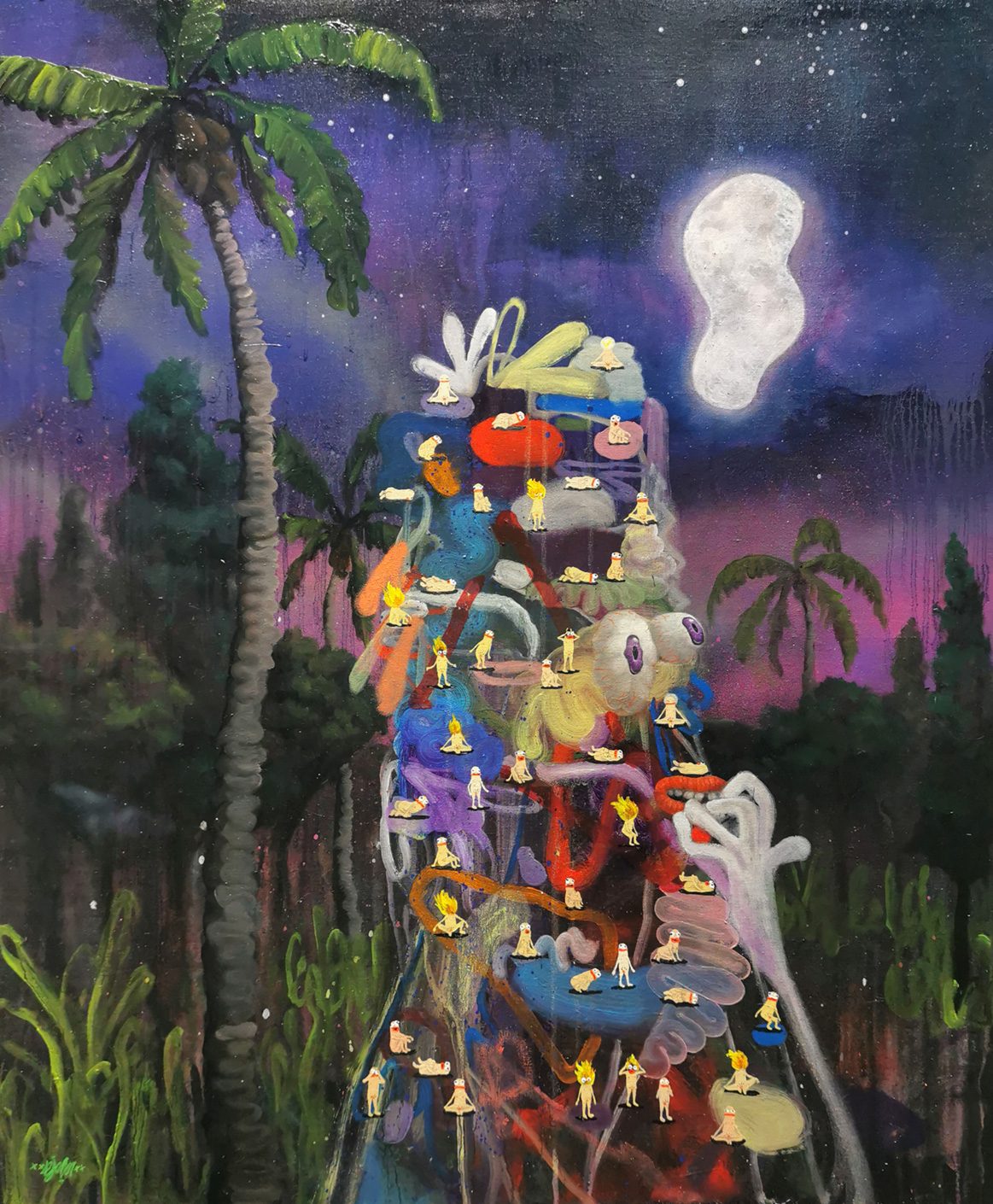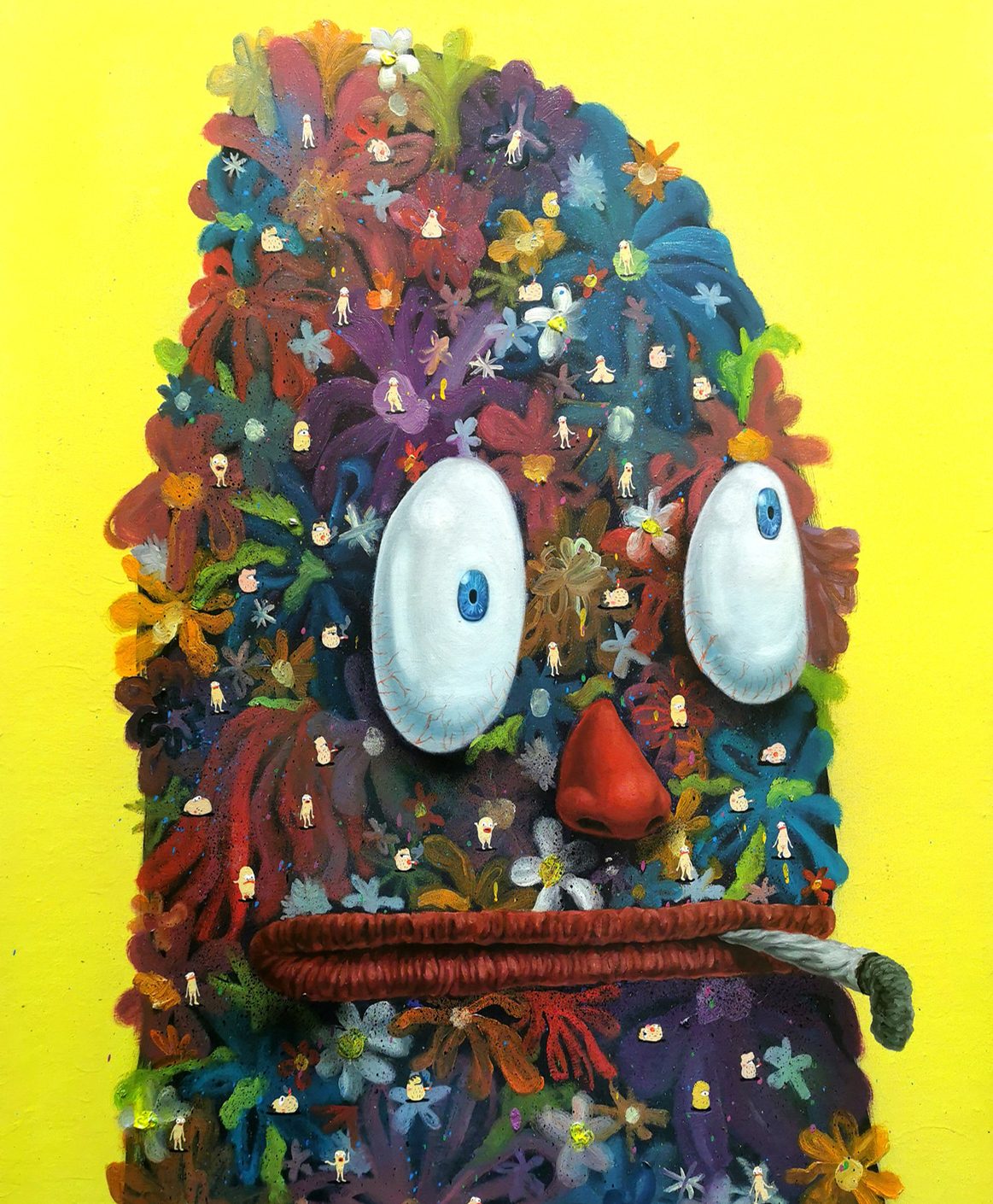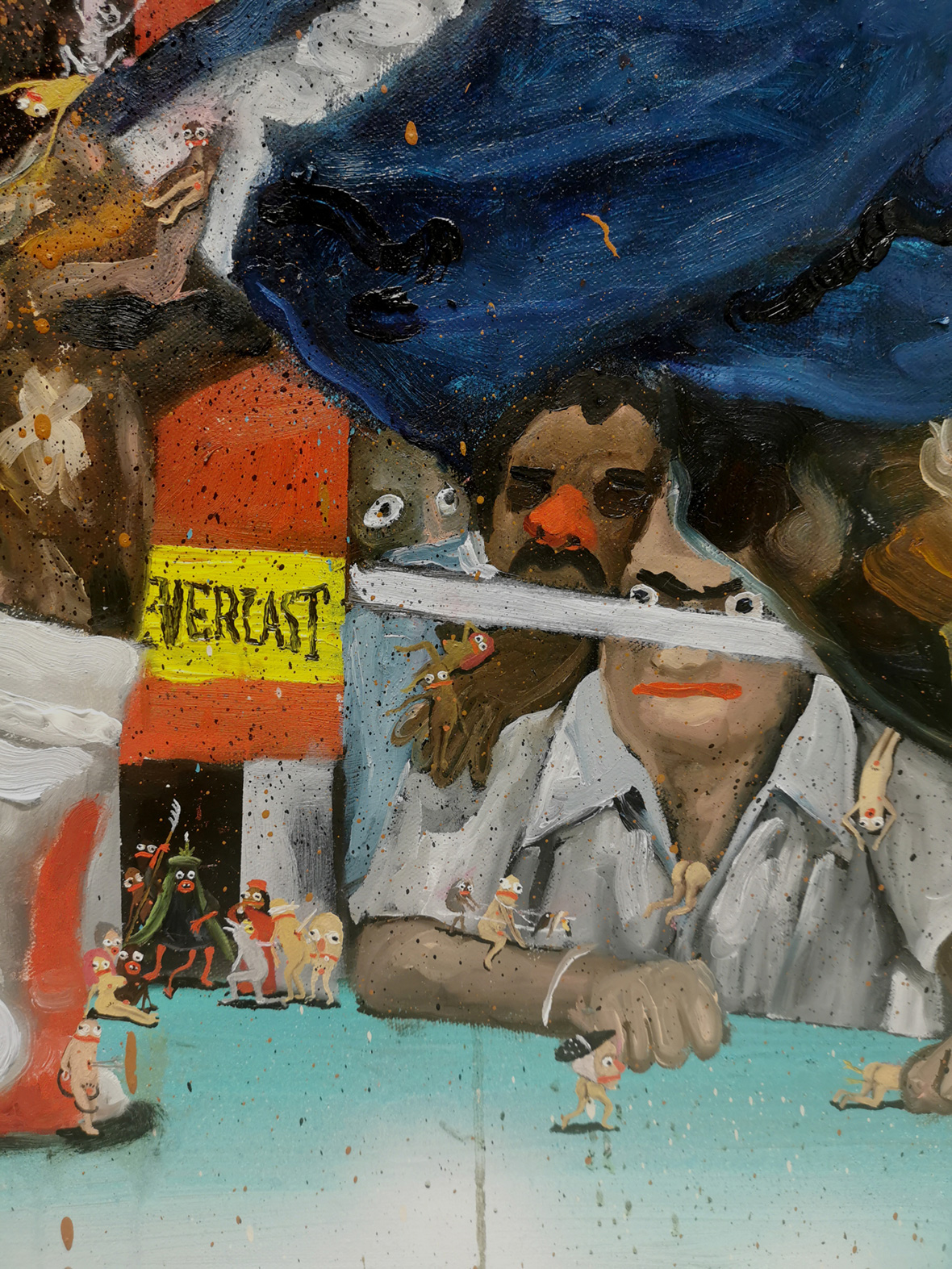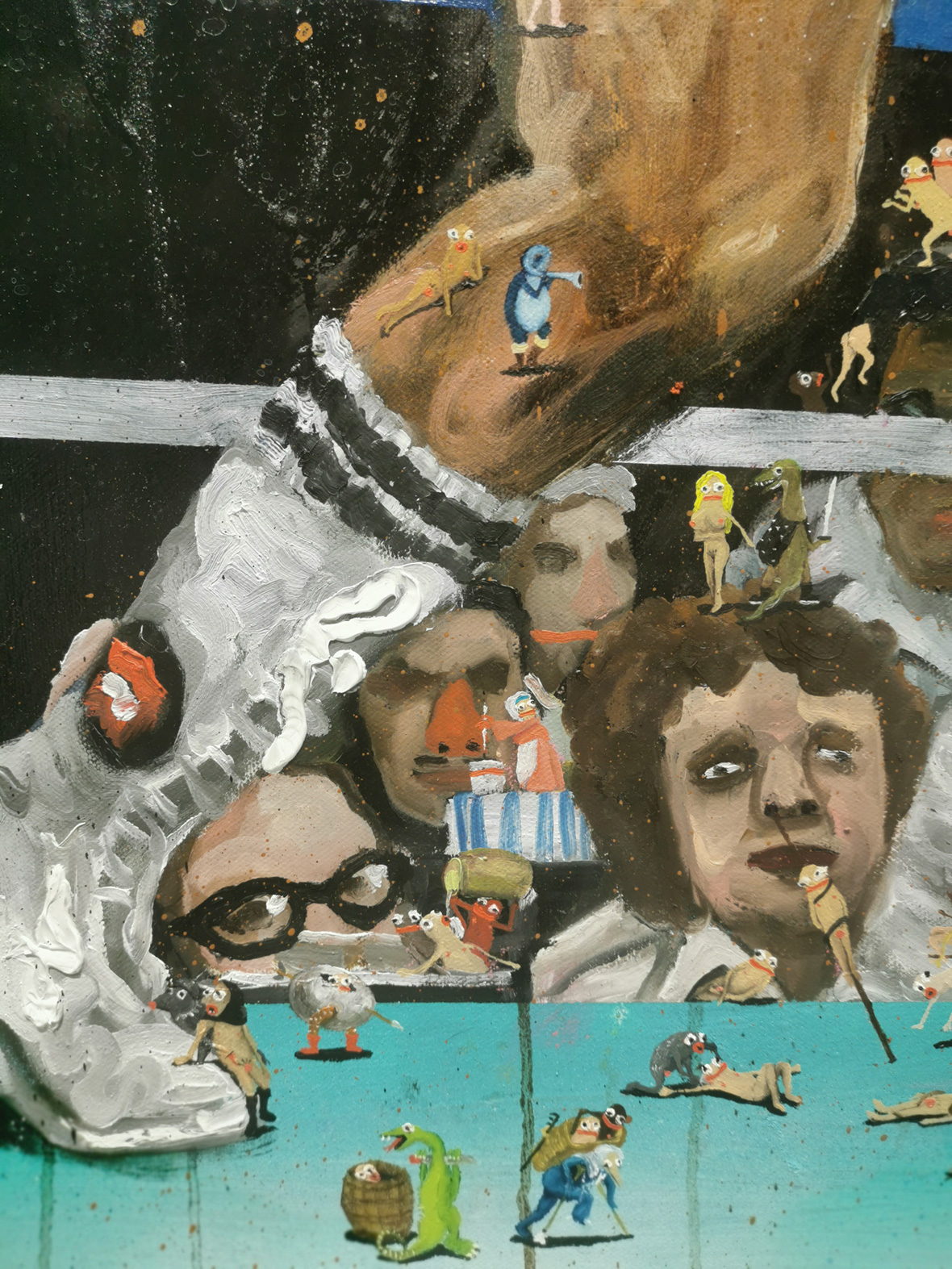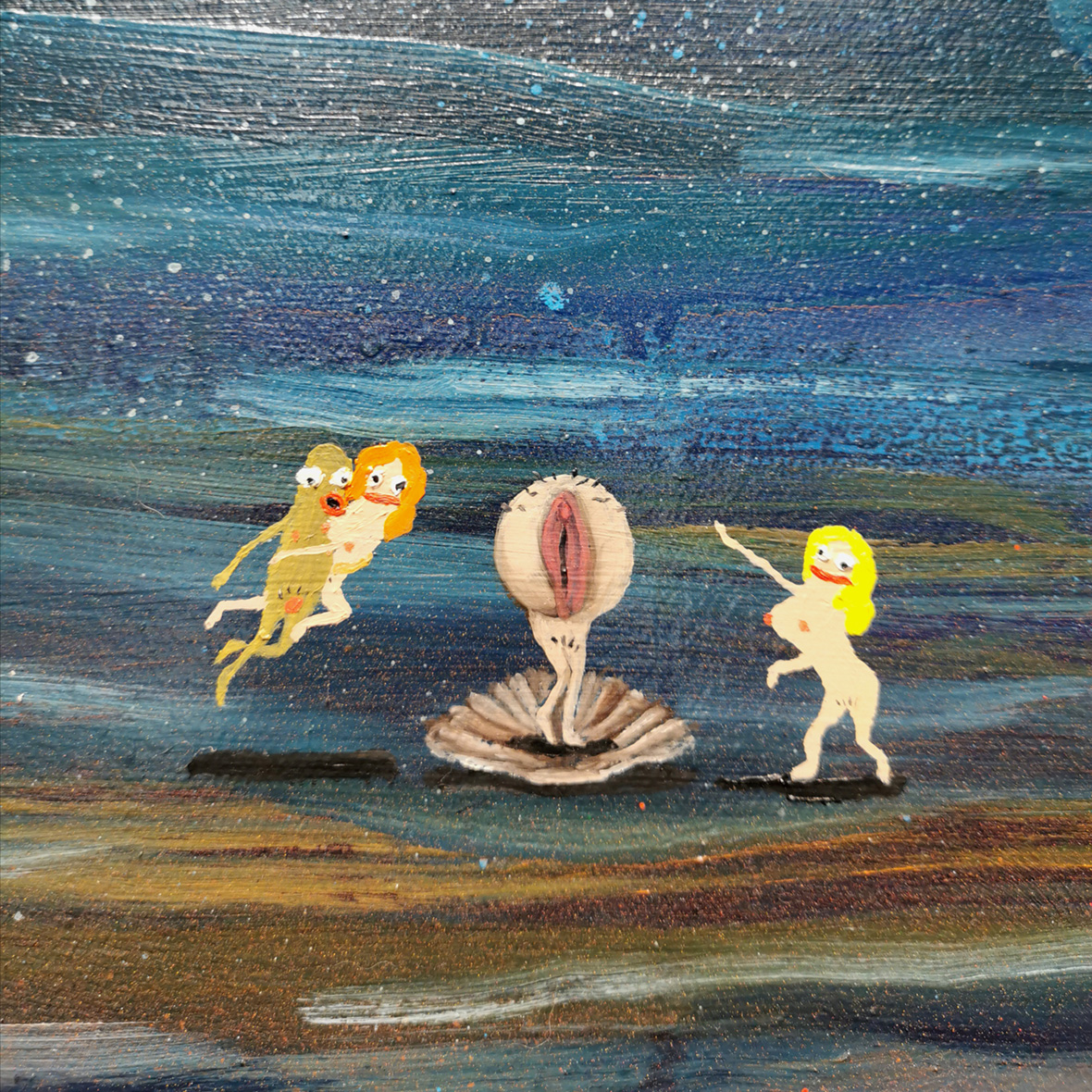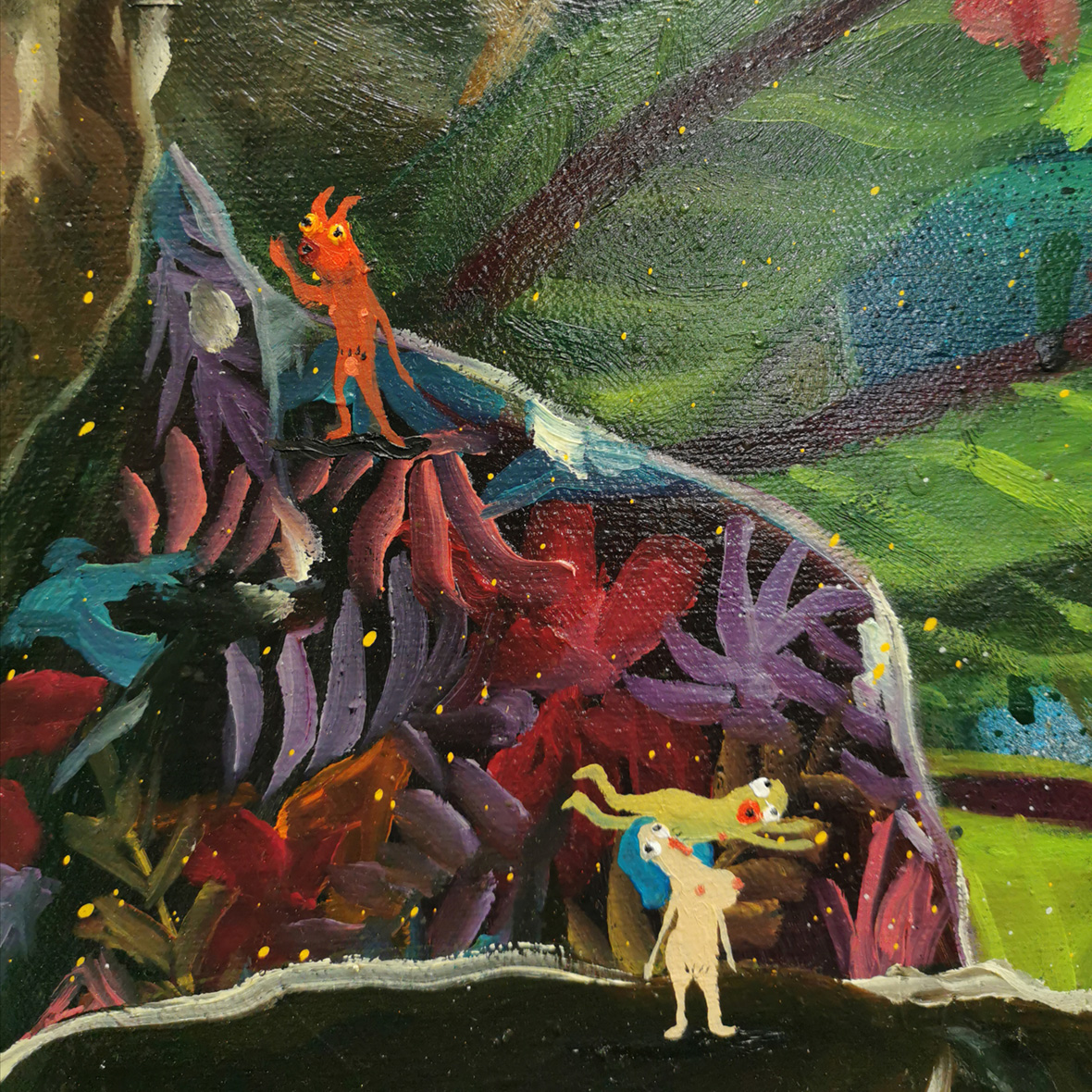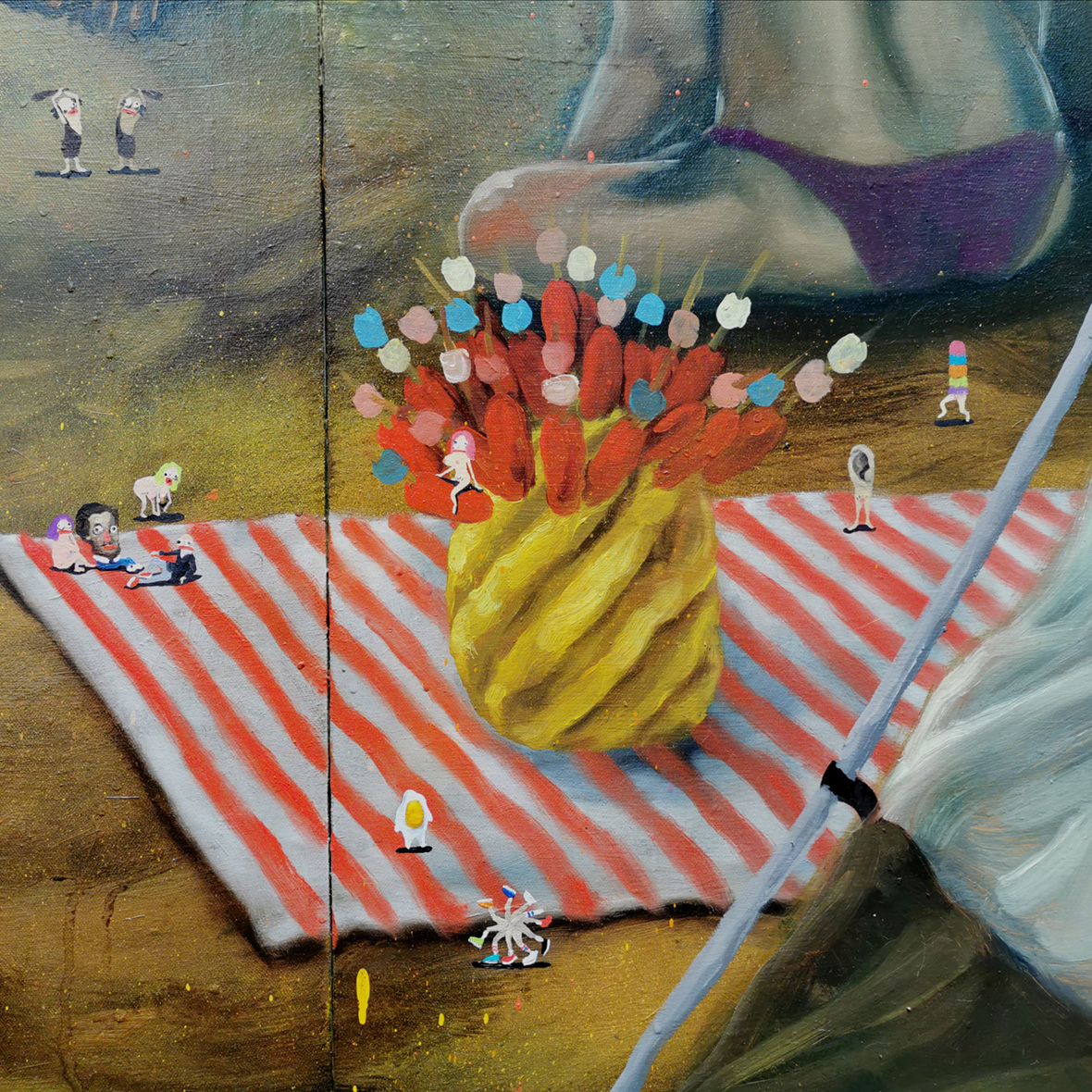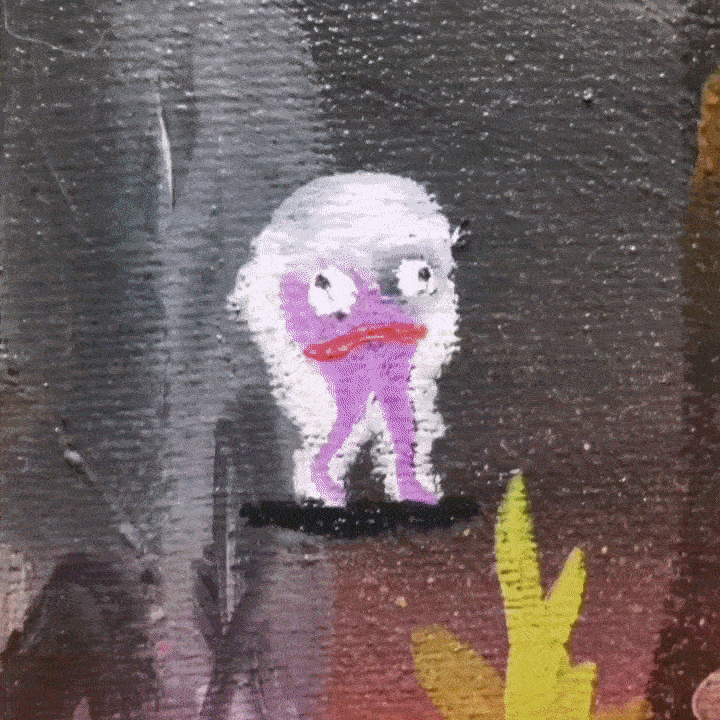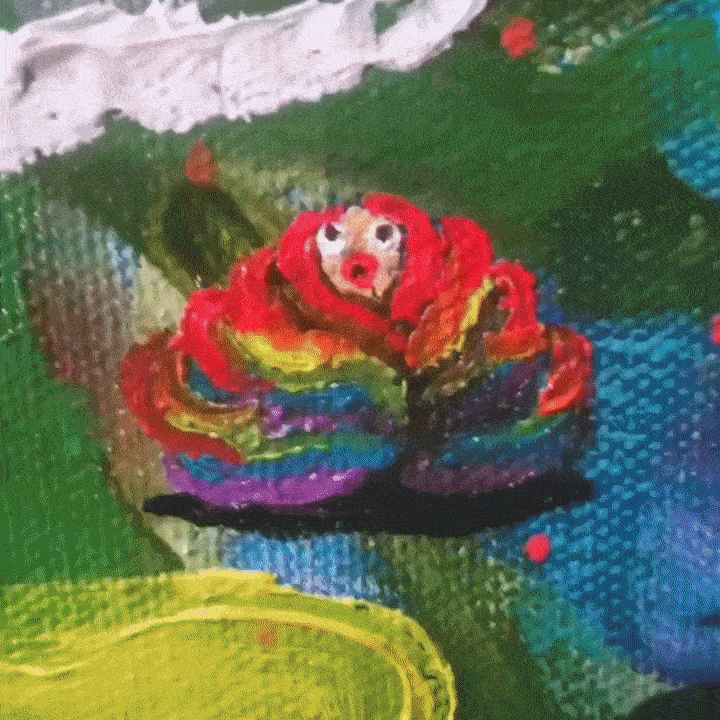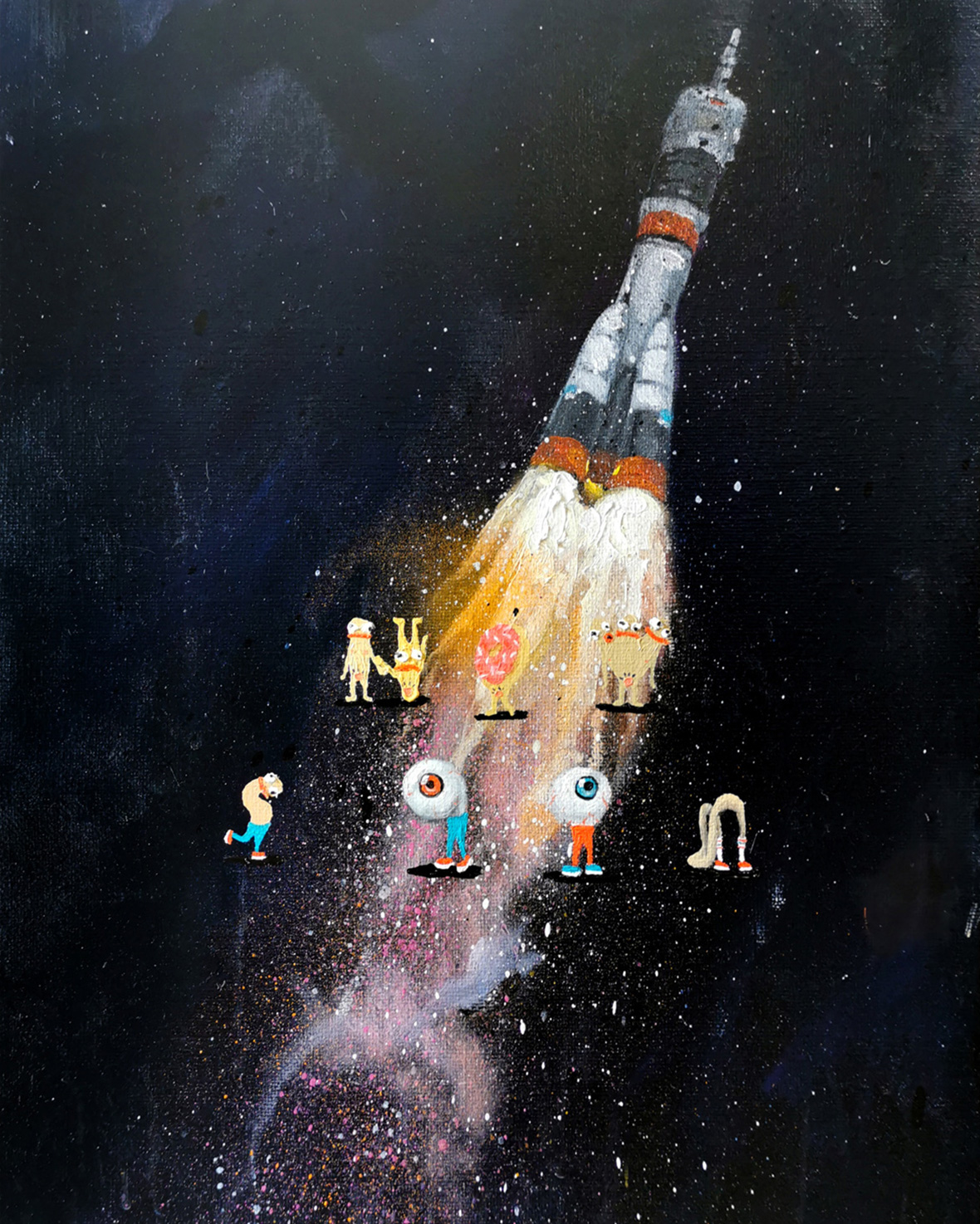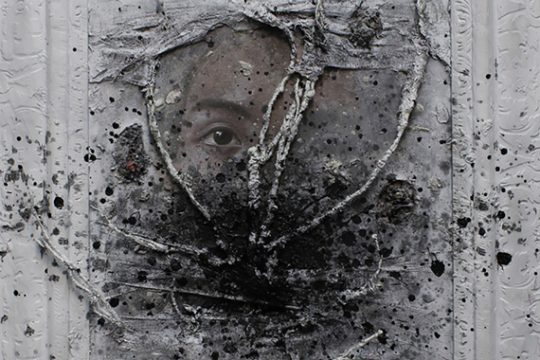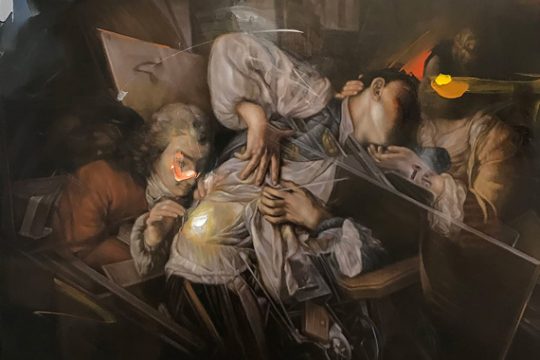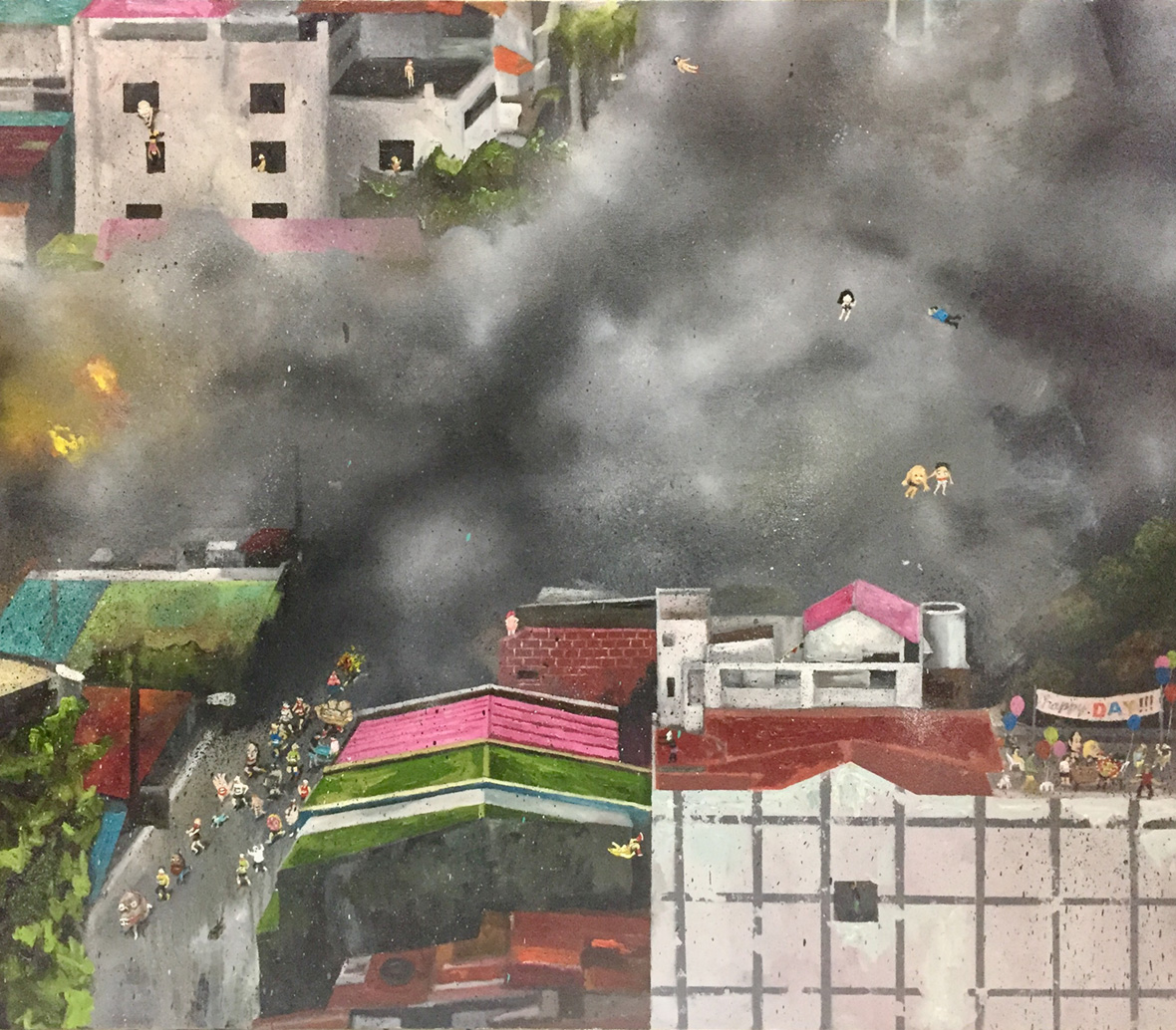
As a five-alarm fire blazes in the streets of Manila, smoke unfurls in massive billows obscuring most of the frame. Despite the unfurling tragedy—with tiny people hanging from windows and falling from the sky like embers—a party is in full swing on a nearby roof and a joyous parade streams down the street under the smoldering sky. The scene, depicted in a painting by Filipino artist Bjorn Calleja, was based on a photo he took of Sampaloc, the neighborhood he grew up in. Despite how dramatic the fire appears on his canvas, it’s an all too common occurrence in the ultra-dense city. The painting suggests that life must go on despite calamity, but also prods at the two sides of willful disregard, examining how it’s at times necessary and but can also be detrimental. Ignorance isn’t bliss when it overtakes you.
画面上,马尼拉大街正燃着雄雄烈火,灰黑的浓烟几乎成为画卷的主色调。浓烟之中的楼宇里,可以看到有人正准备跃窗而逃,空中零星还会看到许多像灰烬一样掉落的小人儿;与此同时,在一旁的屋顶上,派对却正如火如荼地进行;而浓烟之下的大街上也有一支浩浩荡荡的游行队伍,洋溢着快乐的气氛。这个场景是菲律宾画家 Bjorn Calleja 根据他在 Sampaloc 街区拍摄的一张照片而创作的,那里是他从小生活的地方。虽然画中的大火看上去十分夸张,但在这座密集的城市,人们早已见怪不怪。这幅画建议人们 —— 尽管大难临头,也要保持良好的心态,因为生活还要继续;同时也反映了现实生活中漠不关心的彼此,眼看十万火急却袖手旁观,这种行为本身就是一种伤害。而当无知占据所有,任何眼前的快乐都不值得一提。
“I was in a really bad place at that time, and all I could do to cope was paint,” Calleja says, recalling how the 2016 piece was an artistic turning point that led him to the style he’s now known for. “I finished the painting but it felt incomplete, that’s when I started painting the little people. It felt meditative and helped me focus on something, so I adopted them in all my future paintings.” He refers to the tiny figures in his art as “beings,” and they’ve populated all of his paintings since.
Bjorn 说:“当时我的生活很糟糕,唯一能做的就是画画。”2016 年画的这幅画是他艺术创作的转折点,也成为了他最为人熟知的艺术风格。“刚完成这幅画的时候,我总感觉还缺点什么,于是后来又加上了这些小人儿。创作这些小人儿的时候,帮助我静下心来思考作品背后的含义,让创作变得更加专注。”画中的这些小人儿后来成为 Bjorn 作品中常见的元素,被他称为 “众生(Beings)”。
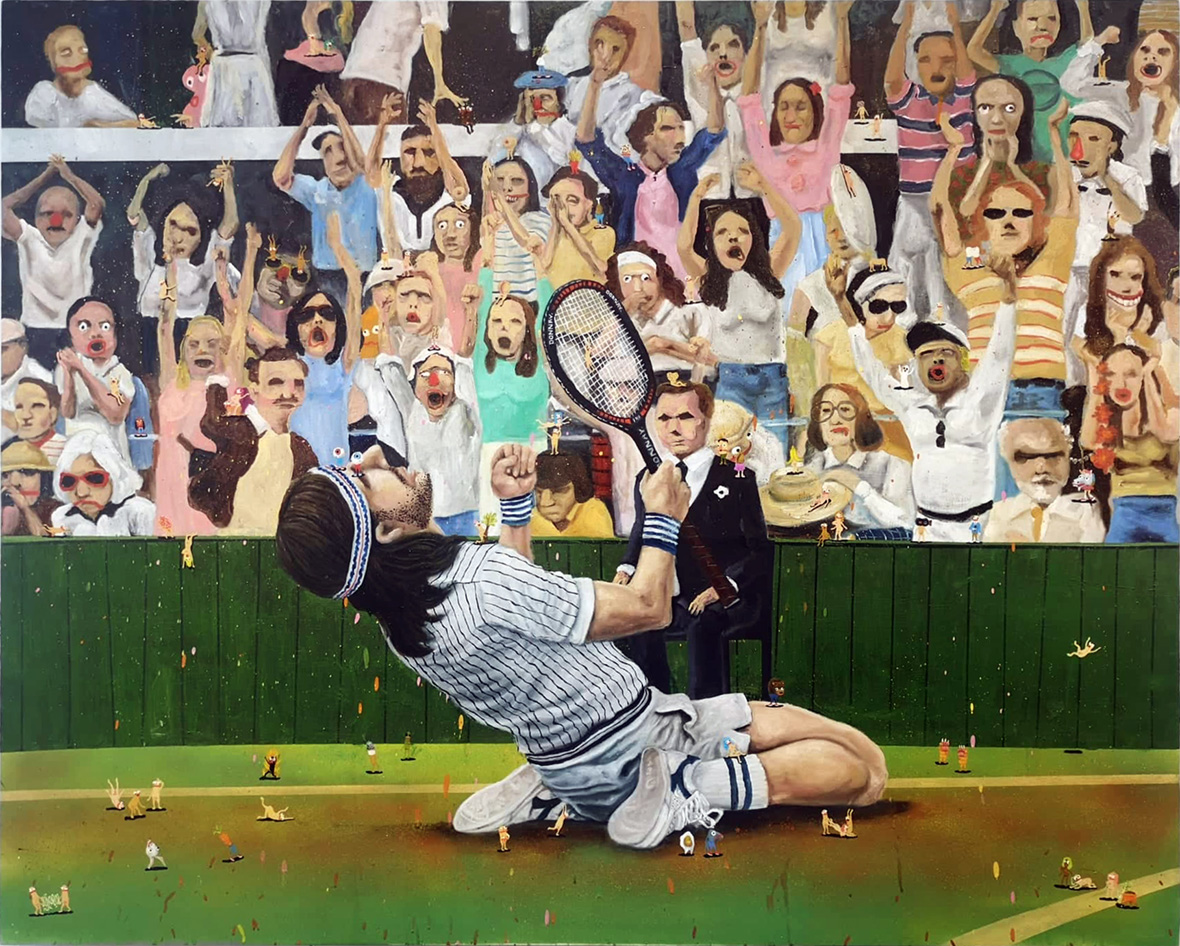
Whether it’s depictions of athletic achievements, a rocket launch, or a day of abandon at the beach, Calleja’s beings squirm and meander across each scene, living out their own intricate lives in miniature. The men are called Adams, the women Eves, and the big-headed characters are Ego, but actually, their names aren’t all that important: “As a collective, I think like humans, names wouldn’t matter much. What matters is how we affect the bigger picture as a species.”
无论是网球比赛、火箭发射,还是在流放在海边的一天,Bjorn 的小人儿总是游荡于不同的场景中,在微观世界里过着五味杂陈的日子。他把笔下的男人和女人分别取名为“亚当斯” 和 “夏娃”,而大头的人物则被称为是 “本体意识”。不过人物叫什么名字对于 Bjorn 来说并不重要:“在集体中,我们的名字并不重要。重要的是我们作为人类,如何对整幅画面产生化学作用。”
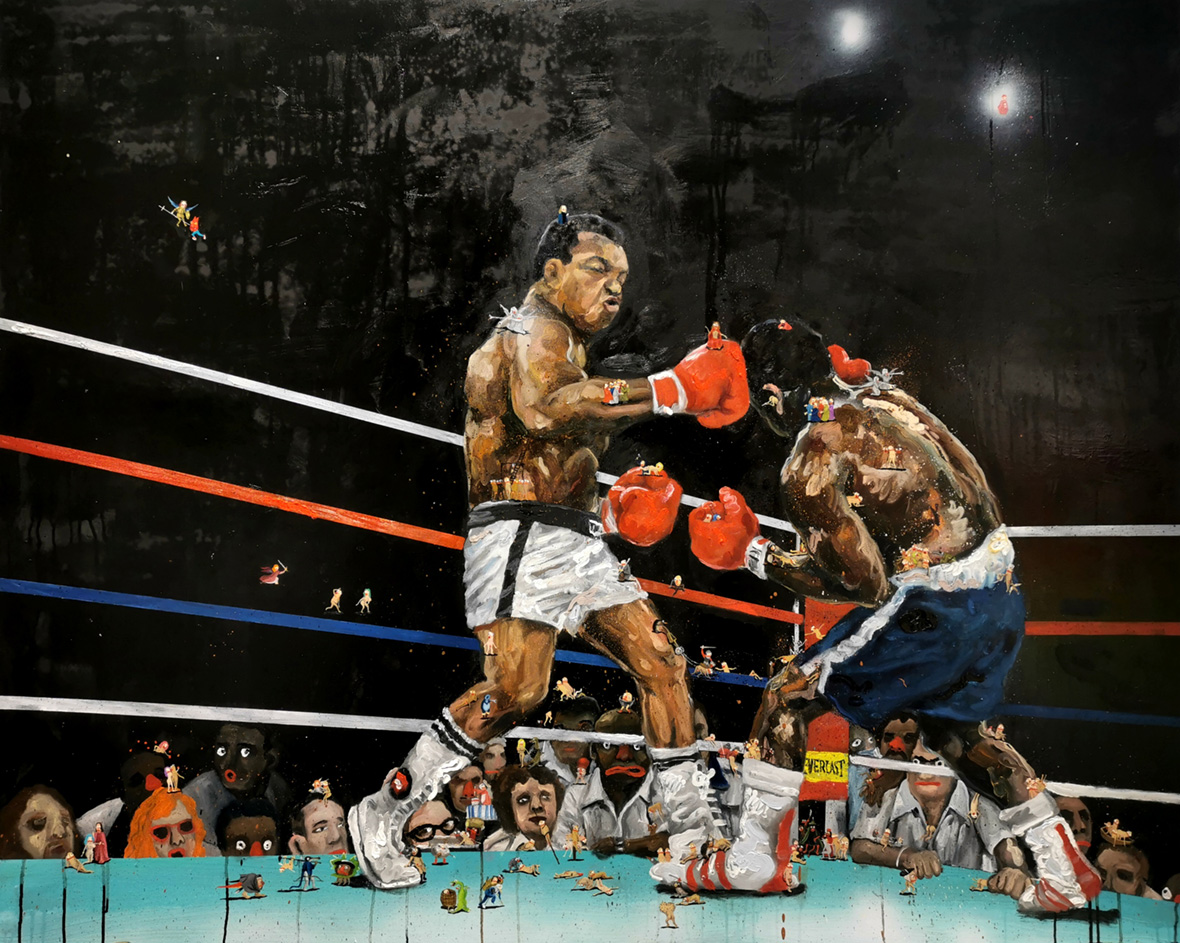
His fascination with the ways people affect the world at large—despite how our actions and decisions as individuals can often seem small and insignificant—is perhaps the result of his upbringing in Sampaloc, a busy Manila neighborhood known for its many universities and affordable eateries. “Sampaloc is a melting pot with a diverse group of people from different social statuses and regions who moved there for work or education,” he says. “I spent most of my teenage years on the streets hanging out with older people. I believe this informed me most about the real urban world: community, poverty, sex, drugs, violence, and hustling. But life can still be really beautiful.”
Bjorn 常常着迷于人类与世界之间的联系,也让他深深感受到人作为个体的渺小。这种着迷也许源于他在马尼拉 Sampaloc 街区长大的经历。这片忙碌的街区一向以众多的大学和平价餐馆而著称。他说:“Sampaloc 是一个文化大熔炉,有形形色色的人,来自不同社会地位和地区,来到这里工作或上学。十几岁的时候,我大部分时间都是在街上与老年人一起,这段经历让我见识到真实的城市生活:社区、贫穷、性、毒品、暴力和嫖娼等等。尽管如此,生活仍然可以过得很好。”
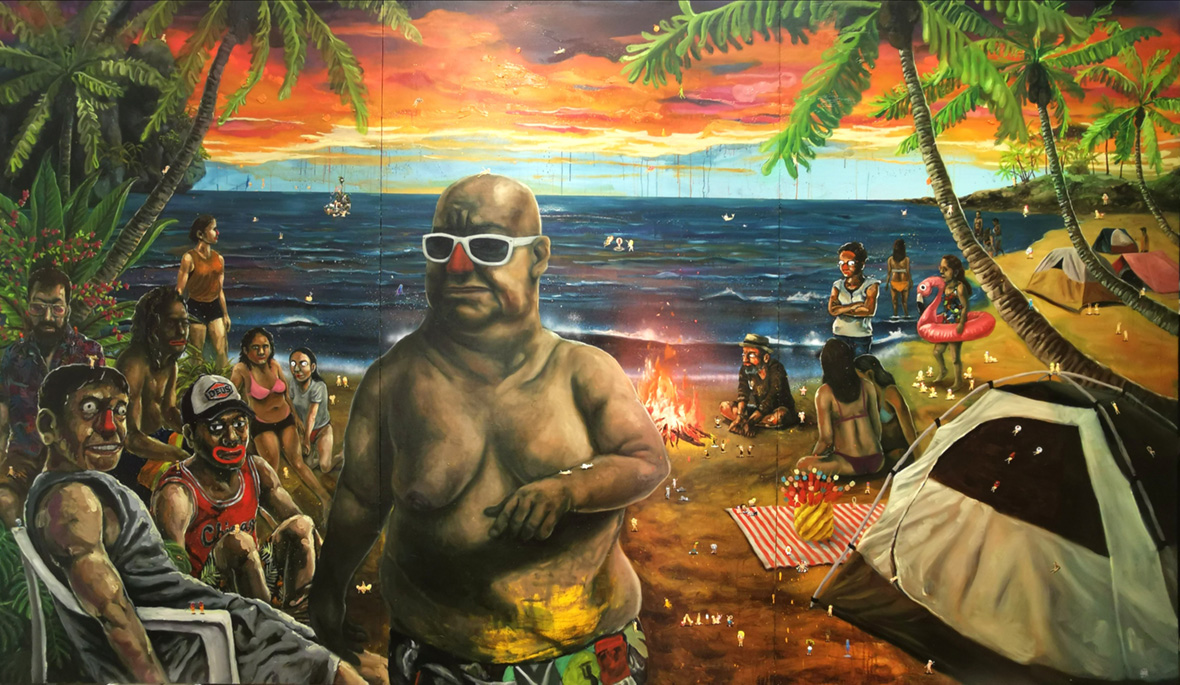
Calleja’s beings also add a level of interaction for viewers; once they take in the larger narrative and theme of each piece, they can step closer to inspect the tiny but expansive lives of these minuscule creatures. Often, they tell a separate story of their own. In one painting, a naked Adam dies, decomposes, turns into a plant, and is reborn. Each step in the cycle is played out across the canvas, almost imperceptibly. Calleja has begun making animated GIFs with a focus on his beings, giving these sideline stories a spotlight of their own.
Bjorn 的小人儿让观众与作品有了更多互动;当观众掌握了整幅作品的叙事和主题后,可以再走近细看,了解这些小人儿丰富的生活。他们时常讲起属于自己的故事。在其中一幅画中,一个赤裸的亚当去世后,他的身体开始分解,变成植物,获得重生,在画中微妙地呈现出生命循环的每一个步骤。如今,他正忙着以这些小人儿创作动画 GIF,讲述这些小人儿的支线故事。
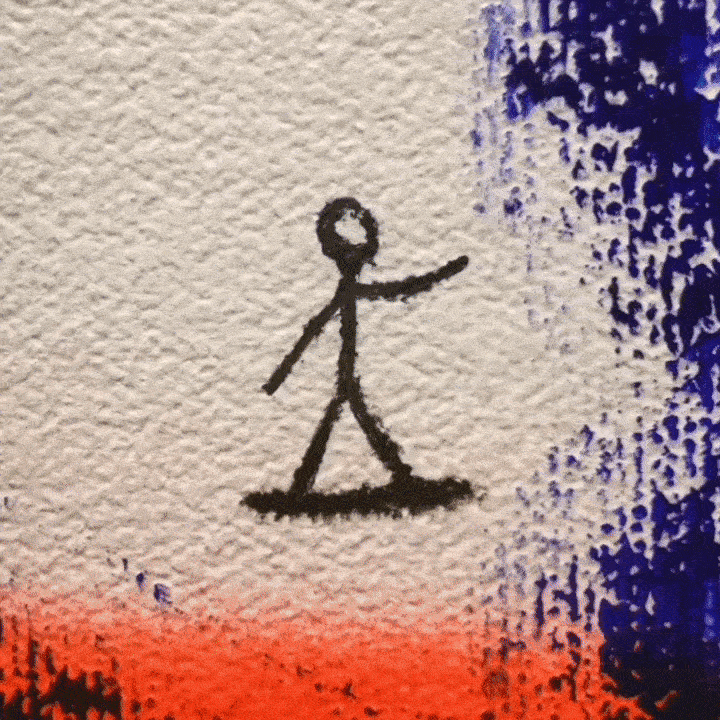
The flux in perception between their hidden life on the canvas versus how they’re front and center in his animations is a disinction Calleja relishes: “I like that the animations speak about transformation and the relationship of time and space within the work on different levels. It keeps me in check with my own space and time, my here and now and how I can transform my own karma.”
画布上,小人儿的故事以隐晦的方式讲述出来;而在动画中,他们却挨个是主角,Bjorn 很喜欢从不同角度讲故事:“我习惯让动画可以带观众去探讨不同时空之间的关系。这也让我不断审视自己所在的时空,引发我对前世今生和因果关系(Karma,来源于佛教)的思考。”
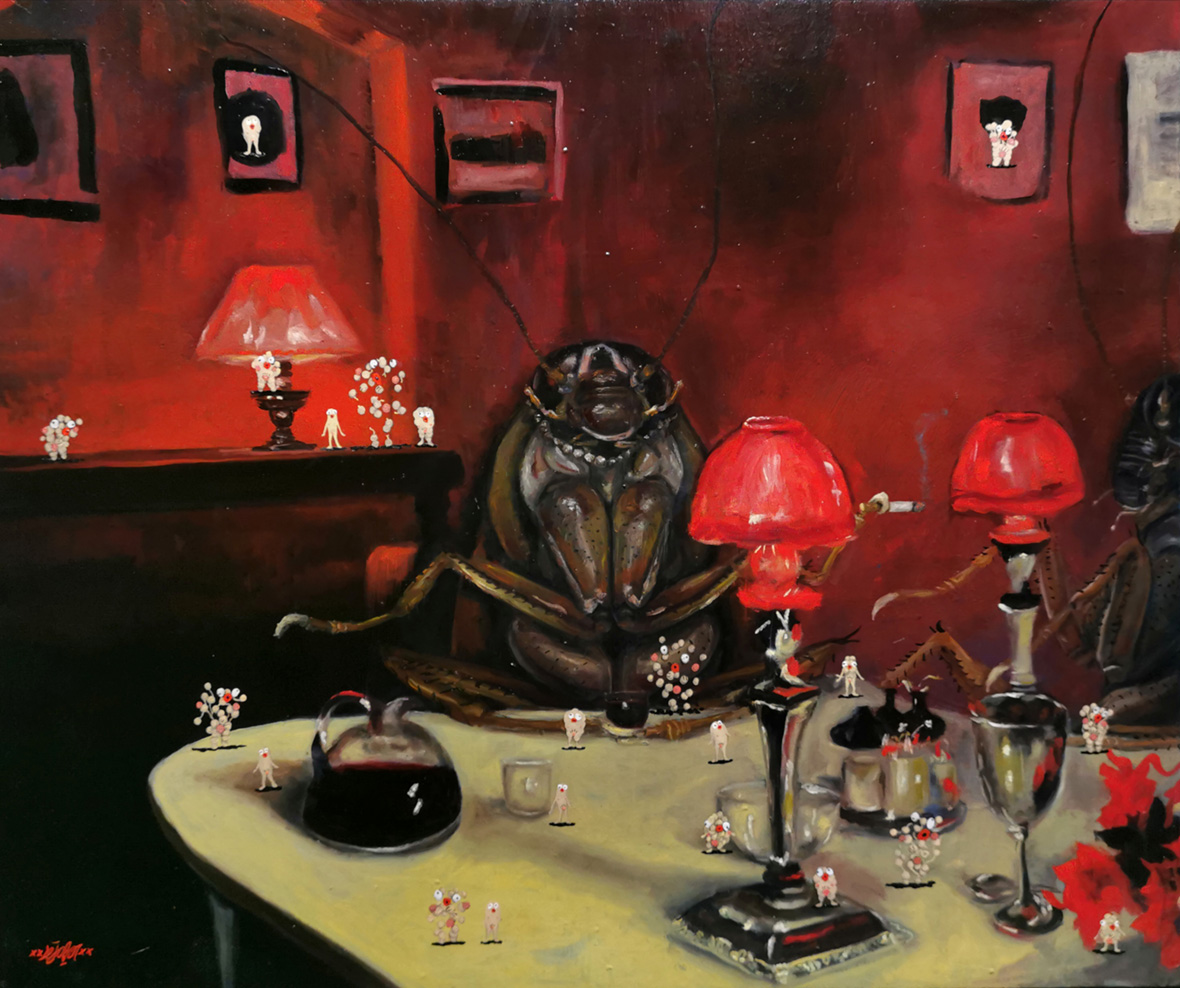
Another key aspect of Calleja’s paintings is the sense of impending doom, as if directly around the corner is the final cliff of humanity that his characters are bound to tumble down. Fires still burn and volcanoes threaten to explode. Under his heavy, textured brushstrokes, even a day at the beach can simmer with forboding energy. But at the same time, there’s a full-throated joy to be found in the humor he readily employs: “Life is funny and people are funny,” Calleja grins. “If we don’t see that, we’ll just be miserable and crazy. We’re all just passing through. Our problem is we think of ourselves too much, the human ego is funny when you just listen to it.”
Bjorn 的作品中,另一个重要特点是那种厄运临头的紧迫感,仿佛他的角色注定要掉落在人类文明的悬崖边上。大火仍在燃烧,火山随时爆发。在他厚重而充满纹理感的笔触之下,即使是在海边的画面,也充斥着某种危机感。但与此同时,在他信手拈来的幽默之中,又洋溢着满满的喜悦,“生活很有趣,人们也很有趣。如果我们意识不到这一点,就只会感到痛苦和疯狂。我们都只是过路人。人们的问题在于太看重自己;认真聆听人类的自我意识,你会发现很多有趣的事情。”他笑着说道。
Like our stories? Follow us on Facebook and Instagram.
Instagram: @osongkalye
Contributor: Mike Steyels
Chinese Translation: Olivia Li

